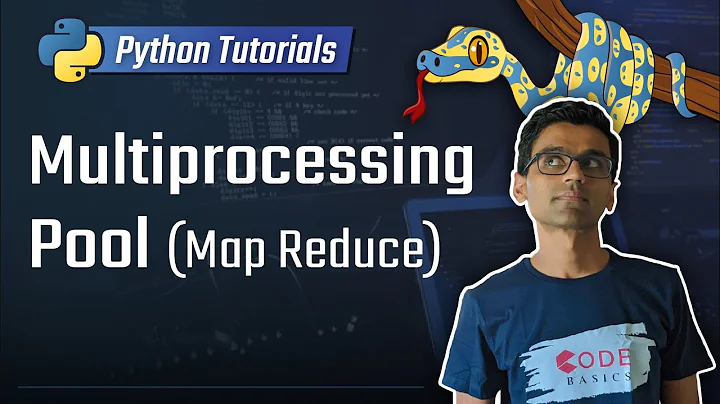Dead simple example of using Multiprocessing Queue, Pool and Locking
Solution 1
The best solution for your problem is to utilize a Pool. Using Queues and having a separate "queue feeding" functionality is probably overkill.
Here's a slightly rearranged version of your program, this time with only 2 processes coralled in a Pool. I believe it's the easiest way to go, with minimal changes to original code:
import multiprocessing
import time
data = (
['a', '2'], ['b', '4'], ['c', '6'], ['d', '8'],
['e', '1'], ['f', '3'], ['g', '5'], ['h', '7']
)
def mp_worker((inputs, the_time)):
print " Processs %s\tWaiting %s seconds" % (inputs, the_time)
time.sleep(int(the_time))
print " Process %s\tDONE" % inputs
def mp_handler():
p = multiprocessing.Pool(2)
p.map(mp_worker, data)
if __name__ == '__main__':
mp_handler()
Note that mp_worker() function now accepts a single argument (a tuple of the two previous arguments) because the map() function chunks up your input data into sublists, each sublist given as a single argument to your worker function.
Output:
Processs a Waiting 2 seconds
Processs b Waiting 4 seconds
Process a DONE
Processs c Waiting 6 seconds
Process b DONE
Processs d Waiting 8 seconds
Process c DONE
Processs e Waiting 1 seconds
Process e DONE
Processs f Waiting 3 seconds
Process d DONE
Processs g Waiting 5 seconds
Process f DONE
Processs h Waiting 7 seconds
Process g DONE
Process h DONE
Edit as per @Thales comment below:
If you want "a lock for each pool limit" so that your processes run in tandem pairs, ala:
A waiting B waiting | A done , B done | C waiting , D waiting | C done, D done | ...
then change the handler function to launch pools (of 2 processes) for each pair of data:
def mp_handler():
subdata = zip(data[0::2], data[1::2])
for task1, task2 in subdata:
p = multiprocessing.Pool(2)
p.map(mp_worker, (task1, task2))
Now your output is:
Processs a Waiting 2 seconds
Processs b Waiting 4 seconds
Process a DONE
Process b DONE
Processs c Waiting 6 seconds
Processs d Waiting 8 seconds
Process c DONE
Process d DONE
Processs e Waiting 1 seconds
Processs f Waiting 3 seconds
Process e DONE
Process f DONE
Processs g Waiting 5 seconds
Processs h Waiting 7 seconds
Process g DONE
Process h DONE
Solution 2
Here is my personal goto for this topic:
Gist here, (pull requests welcome!): https://gist.github.com/thorsummoner/b5b1dfcff7e7fdd334ec
import multiprocessing
import sys
THREADS = 3
# Used to prevent multiple threads from mixing thier output
GLOBALLOCK = multiprocessing.Lock()
def func_worker(args):
"""This function will be called by each thread.
This function can not be a class method.
"""
# Expand list of args into named args.
str1, str2 = args
del args
# Work
# ...
# Serial-only Portion
GLOBALLOCK.acquire()
print(str1)
print(str2)
GLOBALLOCK.release()
def main(argp=None):
"""Multiprocessing Spawn Example
"""
# Create the number of threads you want
pool = multiprocessing.Pool(THREADS)
# Define two jobs, each with two args.
func_args = [
('Hello', 'World',),
('Goodbye', 'World',),
]
try:
pool.map_async(func_worker, func_args).get()
except KeyboardInterrupt:
# Allow ^C to interrupt from any thread.
sys.stdout.write('\033[0m')
sys.stdout.write('User Interupt\n')
pool.close()
if __name__ == '__main__':
main()
Solution 3
This might be not 100% related to the question, but on my search for an example of using multiprocessing with a queue this shows up first on google.
This is a basic example class that you can instantiate and put items in a queue and can wait until queue is finished. That's all I needed.
from multiprocessing import JoinableQueue
from multiprocessing.context import Process
class Renderer:
queue = None
def __init__(self, nb_workers=2):
self.queue = JoinableQueue()
self.processes = [Process(target=self.upload) for i in range(nb_workers)]
for p in self.processes:
p.start()
def render(self, item):
self.queue.put(item)
def upload(self):
while True:
item = self.queue.get()
if item is None:
break
# process your item here
self.queue.task_done()
def terminate(self):
""" wait until queue is empty and terminate processes """
self.queue.join()
for p in self.processes:
p.terminate()
r = Renderer()
r.render(item1)
r.render(item2)
r.terminate()
Solution 4
For everyone using editors like Komodo Edit (win10) add sys.stdout.flush() to:
def mp_worker((inputs, the_time)):
print " Process %s\tWaiting %s seconds" % (inputs, the_time)
time.sleep(int(the_time))
print " Process %s\tDONE" % inputs
sys.stdout.flush()
or as first line to:
if __name__ == '__main__':
sys.stdout.flush()
This helps to see what goes on during the run of the script; in stead of having to look at the black command line box.
Solution 5
Here is an example from my code (for threaded pool, but just change class name and you'll have process pool):
def execute_run(rp):
... do something
pool = ThreadPoolExecutor(6)
for mat in TESTED_MATERIAL:
for en in TESTED_ENERGIES:
for ecut in TESTED_E_CUT:
rp = RunParams(
simulations, DEST_DIR,
PARTICLE, mat, 960, 0.125, ecut, en
)
pool.submit(execute_run, rp)
pool.join()
Basically:
pool = ThreadPoolExecutor(6)creates a pool for 6 threads- Then you have bunch of for's that add tasks to the pool
pool.submit(execute_run, rp)adds a task to pool, first arogument is a function called in in a thread/process, rest of the arguments are passed to the called function.pool.joinwaits until all tasks are done.
Related videos on Youtube
thclpr
Updated on August 04, 2022Comments
-
thclpr over 1 year
I tried to read the documentation at http://docs.python.org/dev/library/multiprocessing.html but I'm still struggling with multiprocessing Queue, Pool and Locking. And for now I was able to build the example below.
Regarding Queue and Pool, I'm not sure if I understood the concept in the right way, so correct me if I'm wrong. What I'm trying to achieve is to process 2 requests at time ( data list have 8 in this example ) so, what should I use? Pool to create 2 processes that can handle two different queues ( 2 at max ) or should I just use Queue to process 2 inputs each time? The lock would be to print the outputs correctly.
import multiprocessing import time data = (['a', '2'], ['b', '4'], ['c', '6'], ['d', '8'], ['e', '1'], ['f', '3'], ['g', '5'], ['h', '7'] ) def mp_handler(var1): for indata in var1: p = multiprocessing.Process(target=mp_worker, args=(indata[0], indata[1])) p.start() def mp_worker(inputs, the_time): print " Processs %s\tWaiting %s seconds" % (inputs, the_time) time.sleep(int(the_time)) print " Process %s\tDONE" % inputs if __name__ == '__main__': mp_handler(data) -
Tim Peters over 10 yearsNote that you're using
concurrent.futures, but the OP is asking aboutmultiprocessingand Python 2.7. -
thclpr over 10 yearsThanks for the simple and direct example of how to do it, But how could i apply the lock for each pool limit? I mean, if you execute the code, i would like to see something like " A waiting B waiting | A done , b done | C waiting , D waiting | C done, D done "
-
Velimir Mlaker over 10 yearsIn other words, you don't want C starting until both A and B are done?
-
thclpr over 10 yearsExactly, i can do it using multiprocessing.Process but i can't figure out how to do it using pool
-
thclpr over 10 yearsThank you a lot, work as intended, but on function mp_handler you are referencing the variable data instead of var1 :)
-
Velimir Mlaker over 10 yearsOkay thanks, I removed
var1altogether, referring to globaldatainstead. -
thclpr over 10 yearsHi, just for curiosity, your example works for pairs of 2 , but for example, if i have a list with 3 or 77 itens on it? What could be done to instead limiting the values on the list using subdata = zip(var1[0::2], var1[1::2]), the functiou just could go out of pairs defined on what i have on p = multiprocessing.Pool(2) ? I mean, suposing i have a list with 107 values, or 10009 , etc... And i only wanted to increase or decrease the pool to process the list?
-
ThorSummoner over 7 yearsI'm not exactly sure is .map_async() is better than .map() in any way.
-
Zelphir Kaltstahl over 7 yearsWhat are
item1anditem2? Are they some kind of task or functions, which will be executed in two different processes? -
 linqu over 7 yearsyes they are tasks or input parameter that get processed in a parallel way.
linqu over 7 yearsyes they are tasks or input parameter that get processed in a parallel way. -
mata about 7 yearsThe argument to
get()is a timeout, is has nothing to do with the number of jobs that are started. -
ThorSummoner about 7 years@mata so, is that meant to be used in a polling loop?
.get(timeout=1)? and is it okay to just say.get()to get the completed list? -
mata about 7 yearsYes,
.get()waits indefinitely until all results are available and returns the list of results. You can use a polling loop to check weather results are available, or you can pass a callback function in themap_async()call which will then be invoked for every result once it becomes available. -
 Amir about 6 years@VelimirMlaker I want to run a function in the background but I have some resource limitations and cannot run the function as many times that I want and want to queue the extra executions of the function. Do you have any idea on how I should do that? I have my question here. Could you please take a look at my question and see if you can give me some hints (or even better, an answer) on how I should do that?
Amir about 6 years@VelimirMlaker I want to run a function in the background but I have some resource limitations and cannot run the function as many times that I want and want to queue the extra executions of the function. Do you have any idea on how I should do that? I have my question here. Could you please take a look at my question and see if you can give me some hints (or even better, an answer) on how I should do that?







